Balinese religion
Bali holds a very unique place in the Indonesian archipelago, being the only island where Hindu religion is still dominant. The spread of Islam in Sumatra and Java from the 14th century eventually left Bali as the only remaining stronghold of what used to be the dominant religion of both islands.
According to the 2010 census, 83% of Bali population adheres to Hinduism (with regional differences, in Central and East Bali more than 90% of the population is Hindu while in Jembrana or Denpasar about 30% of the population is Muslim, mostly immigrants from Java or Lombok).
Bali Hinduism is truly unique. It coalesces many elements of Indian religions with some ancestral animist traditions. Modern day Balinese Hinduism (officialy refered to as Agama Hindu Dharma) was heavily influenced by refugees from Java (many of them priests, artists and leaders) who moved to Bali because they did not accept the development of Islam in their home island.
Most of Balinese respect the Shaivism tradition of Hinduism but a minority follows the Vaishnavism tradition (their high priest is not called a pedanda but a sri empu and doesn’t have to be a Brahmin).
Some places in Bali have maintained more elements of the pre-Javanese exodus culture. Such villages are called Bali Aga and they are logically mostly found in the East and North of the island. Tenganan is the most famous but one can also think about Trunyan, Sembiran, Bongaya … They usually have their own ritual calendar.
Gods
Balinese do worship traditional Hindu gods, primarily Brahma (creator of the world, often represented with 4 faces), Vishnu (the master of life, often represented riding the mythical Garuda eagle) and Shiva (the destructor). Many other elements of the Hindu pantheon are worshiped : Sri (the goddess of rice and fertility), Saraswati (the goddess of wisdom, art and litterature) or Bhoma whose face is carved over many doors and portals.
Gods often come in pair (a male and a female), almost all natural elements have their divinity : the moon, the sea, the rain …
All Hindu gods are thought to be the different incarnations of a supreme God : Sang Hyang Widhi Wasa. This Balinese particularity owes much to the constitution of the Republic of Indonesia : to be officialy recognized, a religion must be monotheistic. By this theological adaptation who goes back to the 1950s, Balinese Hindu fits into the official definition of the religion.
Besides Hindu gods, some local divinities are also worshiped, for instance Kanjeng Ratu Kidul, the queen of the southern seas (which is also still worshiped in Java). Even some Chinese divinities are worshipped by some families for historical reasons.
Conception of the world
Balinese has imported a typical Indian conception of the world. The universe (Bhuana Agung) is divided in 3 parts :
- Suarga, the residence of the Gods, associated with the moutains and the sky. This is where a man’s spirit returns after death awaiting reincarnation.
- Bhuwah, the world of men, ie the earth.
- Bhur, the underworld populated with demons and also the dwelling place of Bedawang Nala, the world turtle who carries the earth on its back surrounded by the two dragon-snakes Naga Basuki and Naga Anantaboga. This is also where man’s spirit is punished for its misdeeds.
This mirrors the trinity of supreme divinities (Trisakti or Trimurti) : Brahma, Vishnu and Shiva that Balinese consider as the different incarnation of the supreme God. Life is also a 3 steps process : birth, life and death. That’s why any village will always have 3 temples : Pura Puseh (dedicated to Vishnu), Pura Desa (dedicated to Brahma) and Pura Dalem (dedicated to Shiva).
Human being (also called Bhuwana Alit ‘the little universe’) is also divided in 3 parts : the head, the body and the feet. This is why Balinese do wear a kain (the piece of fabric worn around the waist) in temples : to separate the upper pure part of the body from the lower impure.
The practice of religion
Daily offerings
The Balinese philosophy is based on the opposition of order (dharma) and disorder (adharma). The important thing is to maintain the balance between those two states. All religious rituals aim at preserving or re-establishing the equilibrium.
Simple offerings (canang sari) made of a palm-leaf basket, flowers, incense and fruits are disposed everyday in the family compound. About 15 baskets are required (some for the family shrines, one for each God of the trinity, one for Ibu Pertiwi ‘Mother Earth’, and four outside the front door). It is not a problem to step on a canang if the incense is not burning anymore.
A woman usually perform this daily ritual (unless she is spiritually unfit due to menstruation). She dips a flower into holy water and sprinkles the offering with it (thus completing the fusion of the 4 elements). She waves her hand three time while reciting a prayer in order to send the smoke up to God.
The canang sari shows gratitude to the Gods but also appease the demons of the underworld. Hence it helps bring balance on Earth. The offerings for Gods are placed on a higher position while the offering for demons (like the one place in front of the main door of the compound) are placed on the ground.

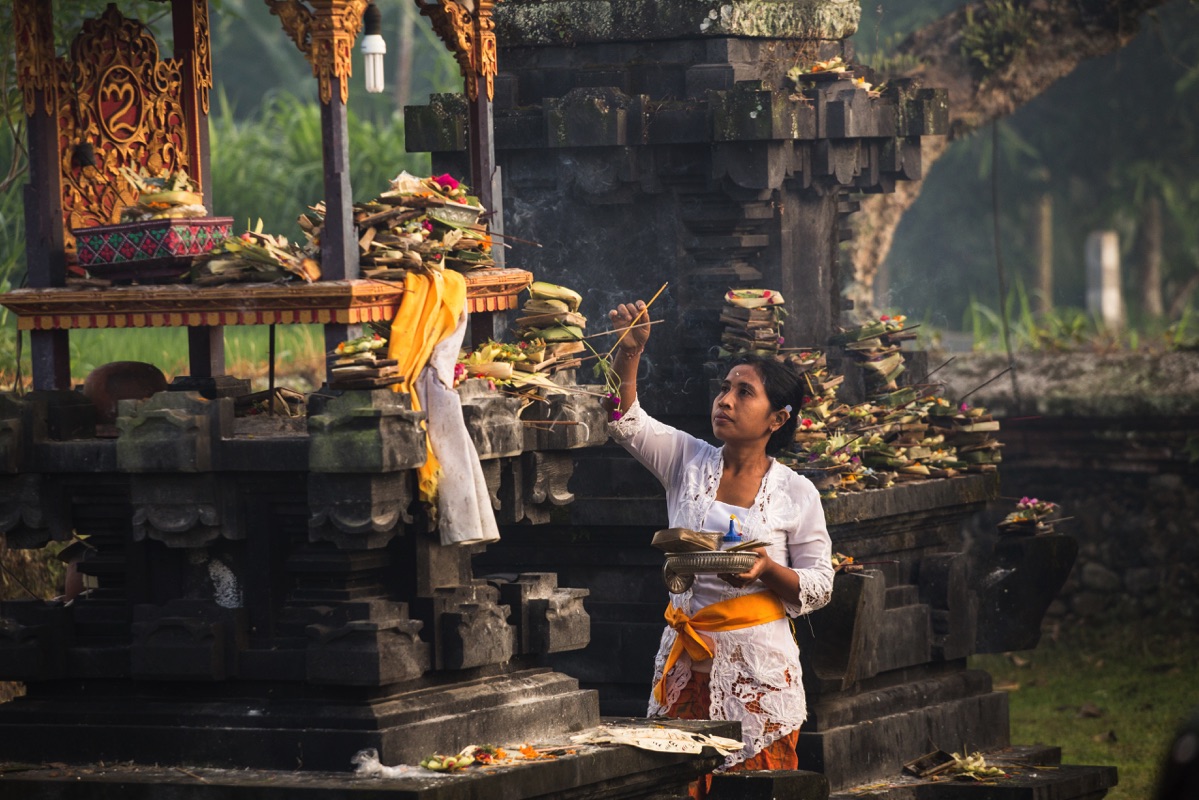
Different other kinds of offering also exist, like the spectacular high offering carried by women on their head (banten tegeh) or the animal sacrificed to the demons (caru).
Prayers
You need a basket with flowers and incense to pray. The proper outfit must also be worn. If a priest is present, he will lead the prayer by using a bell.
Men sits cross-legged and women on their knee. After you wash you hand in the smoke of the incense, you pray first with open hand. Then 3 times with the hands joined, holding a flower between the fingertips. The flower is usually put in the hair or behind the ears after use.
The priest (pemangku) will then pass among every person. You keep your hand open in front of you to get some holy water (tirta). The priest will give you water three times, you drink it also three times, then he will hand over some wet rice. You take some of it and put in on your forehead (other places are also possible).
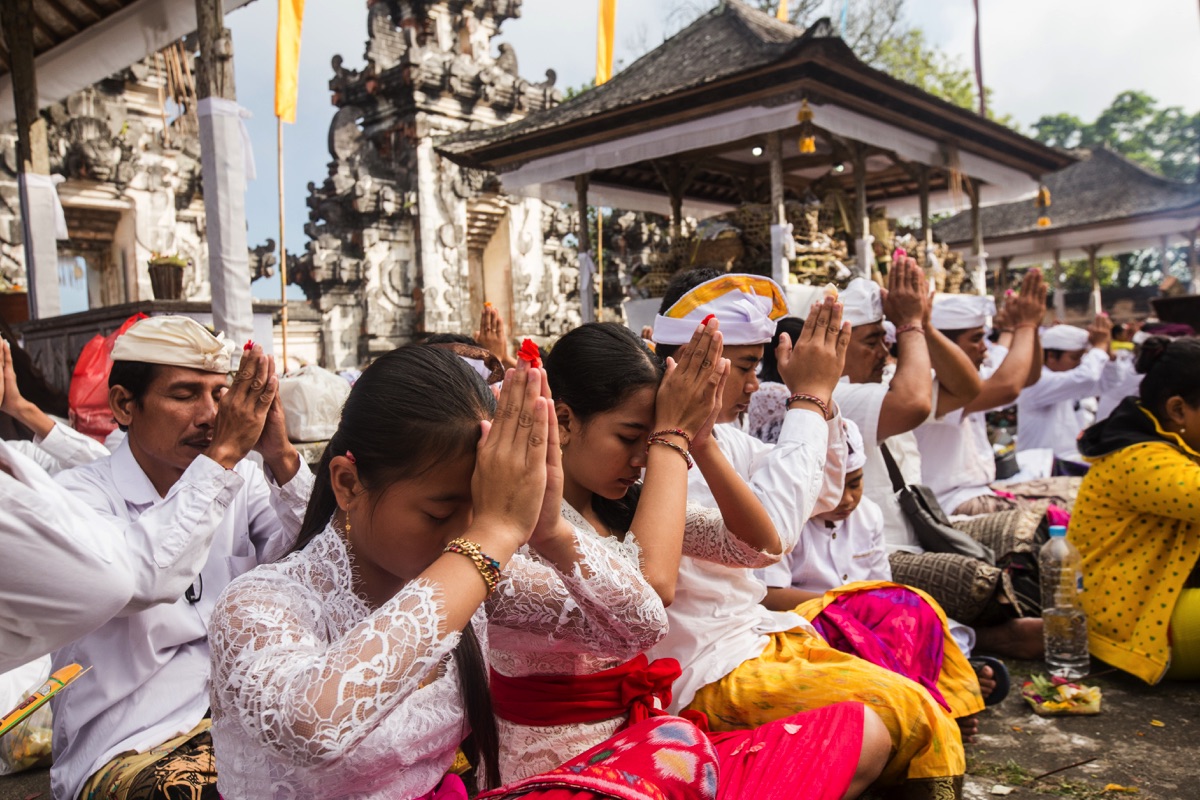
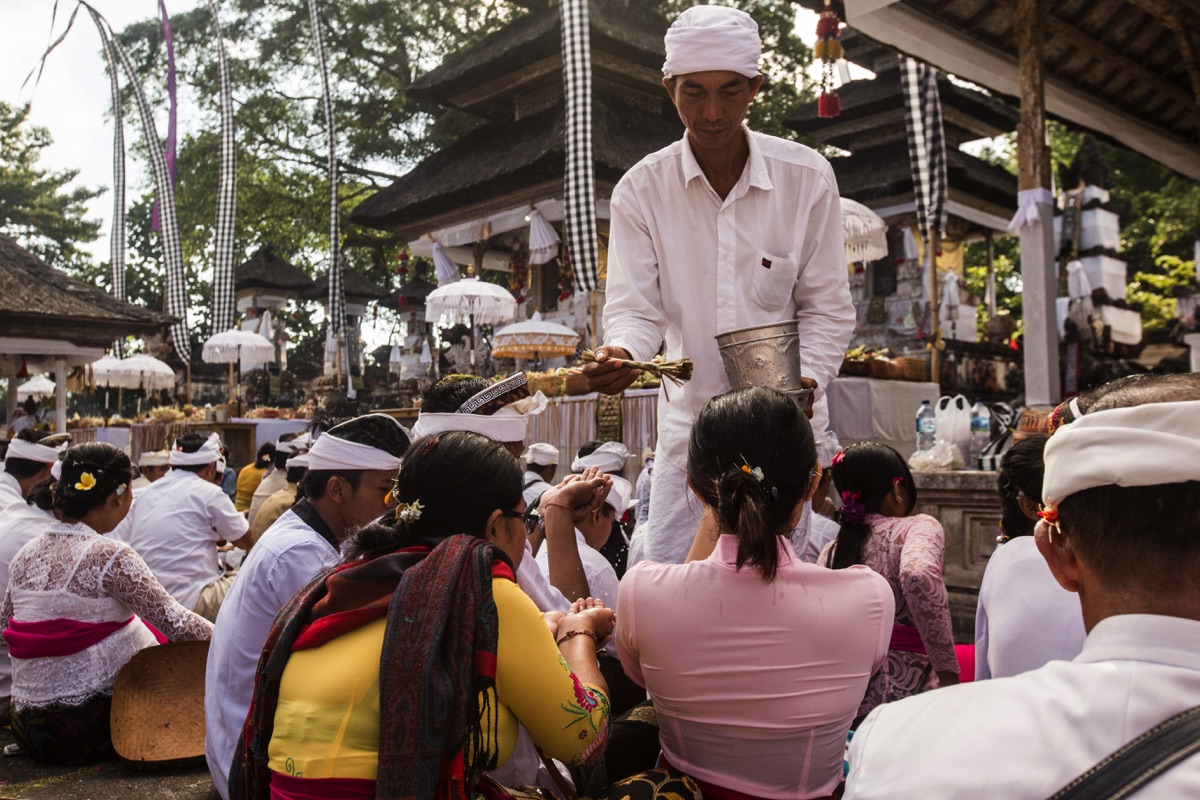
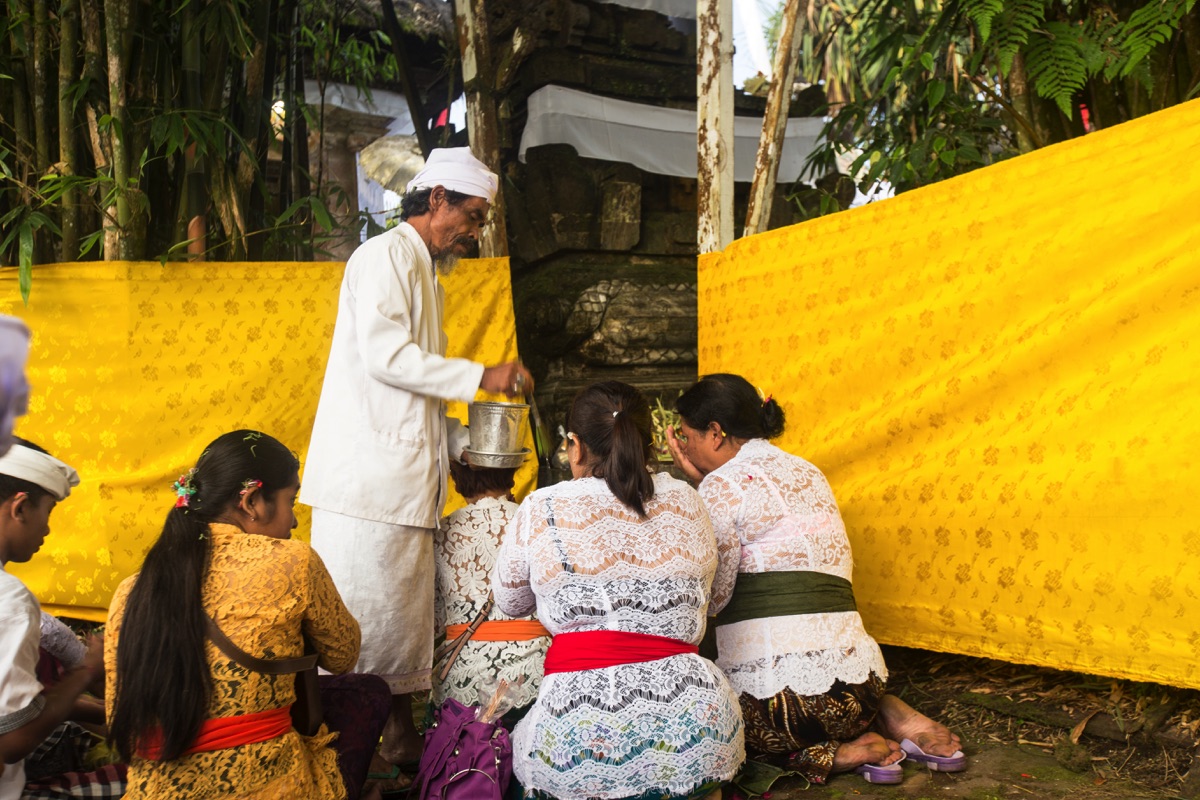
Purification
The main purification ritual is called melukat. Balinese do regularly fulfill this ritual, especially after they recover from sickness, after a relative have passed away or when they are back from a journey.
After the proper offerings have been made, the person has to take a bath in a holy spring (beji). Tirta Empul is the most famous and maybe the most sacred (because its creation goes back to the mythical origin of Galungan celebration) but there are hundred of others all over Bali (almost in every village actually).
Purification by fire (melukat geni) also exists.
Other regular rituals
Balinese use an old Indian 210 days calendar (in addition to another Indian calendar called saka, more details on it latter). It is further divided into 6 35-days months (pawukon).
On top of that 10 distinct kind of weeks are overlayed (one-day weeks, two-day weeks and so on until ten-day weeks). Nevertheless only the three-day (triwara), five-day (pancawara) and seven-day (saptawara) weeks are really important.
Coincidence days (days which mark the end of different kind of weeks) are auspicious days very fit for festivals or ceremonies. When the last day of the three-day weeks falls on the same day as the last day of the five-day weeks it’s called a Kajeng Keliwon for instance (happens every 15 days).
There is one Saturday per month (so 6 per Balinese year) dedicated to a particular benediction. Tumpek Landep (originally for sacred weapons, now encompasses all metal objects in particular vehicles), Tumpek Kandang (for the cattle), Tumpek Uduh (for trees and especially coconut palms), Tumpek Kuningan (which is Kuningan ceremony), Tumpek Ringgit / Wayang (for the shadow play puppets) and Tumpek Krulut (for musical instruments, masks and dance costumes).
Full moon (purnama) and new moon (tilem) are important ritual days. More important offerings are required on those two days. They are also auspicious dates, well suited to plant crops. Lots of temple anniversary (odalan) are held at these dates.
Any temple has an anniversary (odalan) every 210 days. On this occasion it is decorated and people come to pray there and bring offerings.
Priests
Priests are the medium between the Sekala (the visible world) and the Niskala (invisible world).
The highest priests are called pedanda, they are all from the Brahmins caste and the position is often hereditary. To become a pedanda, one has to be already quite old and be teached by another pedanda. Once the training is complete, an introduction ceremony is held whose Balinese name means “second birth”. The main role of the pedanda is to prepare the holy water (tirta) used in any ritual. They are also regularly called upon to lead baptism, weddings or funerals.
Common priests are called pemangku. It doesn’t have to be a full-time activity and virtually any family have at least one member who is a pemangku. Others are the guardian of a given temple and they conduct the ceremonies held there. Both men and women can become a pemangku.
A less known kind of priest is called sengguhu. He is the specialist of the underworld.
Traditional healers (balian) are not priests and don’t adress gods directly. They are nonetheless gifted with the capacity to act on the niskala domain through offerings, mantras or trance. They usually specialize themselves in a particular lore. Balian tenung are versed into the art of divination while balian taksu are primarily spirits medium for instance.
Galungan and Kuningan ceremonies
This 10 days period is the most important of the Balinese calendar. Galungan is the first ceremony, held on the Wednesday of the 12th week of the Balinese calendar (hence the 84th day of the Balinese year, always a Wednesday given this calendar has 210 days). Kuningan is 10 days after Galungan.
On Galungan, Balinese celebrate the victory of the god Indra on the evil king Mayadenawa (who banned the people from praying and destroyed all the temples), which symbolicay represent the victory of good (dharma) on evil (adharma). Gods and ancestors are believed to come down on Earth on this day to visit the family.
On this occasion, the streets are decorated with bamboo poles (penjor) and families usually kill a pig. Special offerings prepared for weeks by the women are brought to temples. People put on their best outfit on this day. From the day before (panampahan Galungan) until the one after Galungan (manis Galungan), many Balinese go on holiday and visit their home village.
On Kuningan (10 days after Galungan, so always a Saturday), the Gods and the ancestors return to heaven at noon. The supreme God, Sang Hyang Widhi Wasa, is also thought to descend on Earth to distribute his blessings.
On this occasion, new offerings are prepared, including yellow rice (hence the name Kuningan from kuning : yellow). It also common to see gedogan or more refined endongan (fruit-towers offerings carried by women on their head) and tamyang (that looks a bit like a dreamcatcher) on this day.
Balinese New Year : Nyepi
Nyepi celebrates the New Year but not based on the 210-days pawukon calendar but on an old Indian lunar calendar called saka (which duration is roughly similar to the Gregorian calendar’s, but is 78 years behind).
The saka calendar has 12 named month, starting on the day after the new moon (tilem), celebrating the full moon in between, and ending on the next new moon. The month are generaly numbered from 1 to 12 based on the ethymology of their name (3 for katiga or 5 for kalima). But don’t get confused because the new year starts on the first day of kadasa month (the 10th month).
A few days before Nyepi (usually 3 or 4 days), Balinese perform a huge purification ritual called melasti. The representation of Gods (pratima) of any village is brought to the nearest beach (or lake or river for those living near the moutain) in a spectacular procession to be purified. Behind the pratima, men also carry gamelan, umbrellas (tedung), barong masks … People wear their white ceremonial clothes on this occasion.By doing so, both the spirit of the people as well as the universe are also purified.
The day before Nyepi, Balinese parade the demonic figures of Ogoh-Ogoh in the streets. They used to be burn afterwards but nowadays this is more and more forbidden by the authorities.
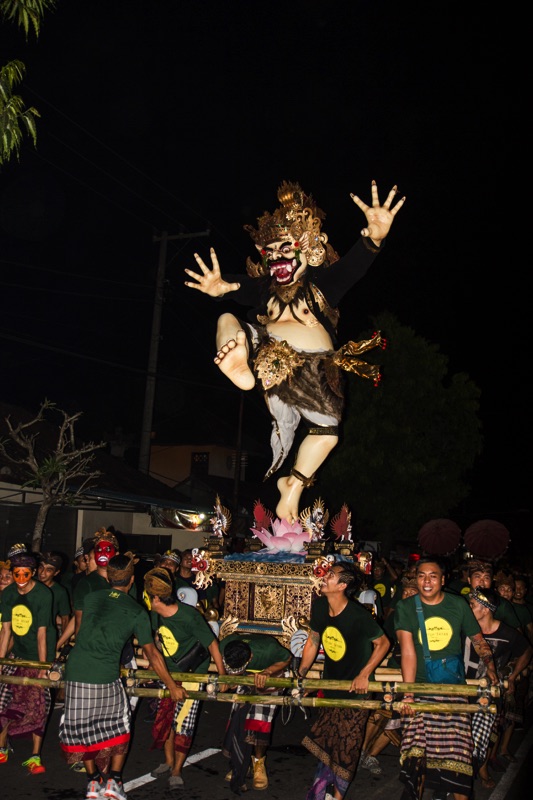
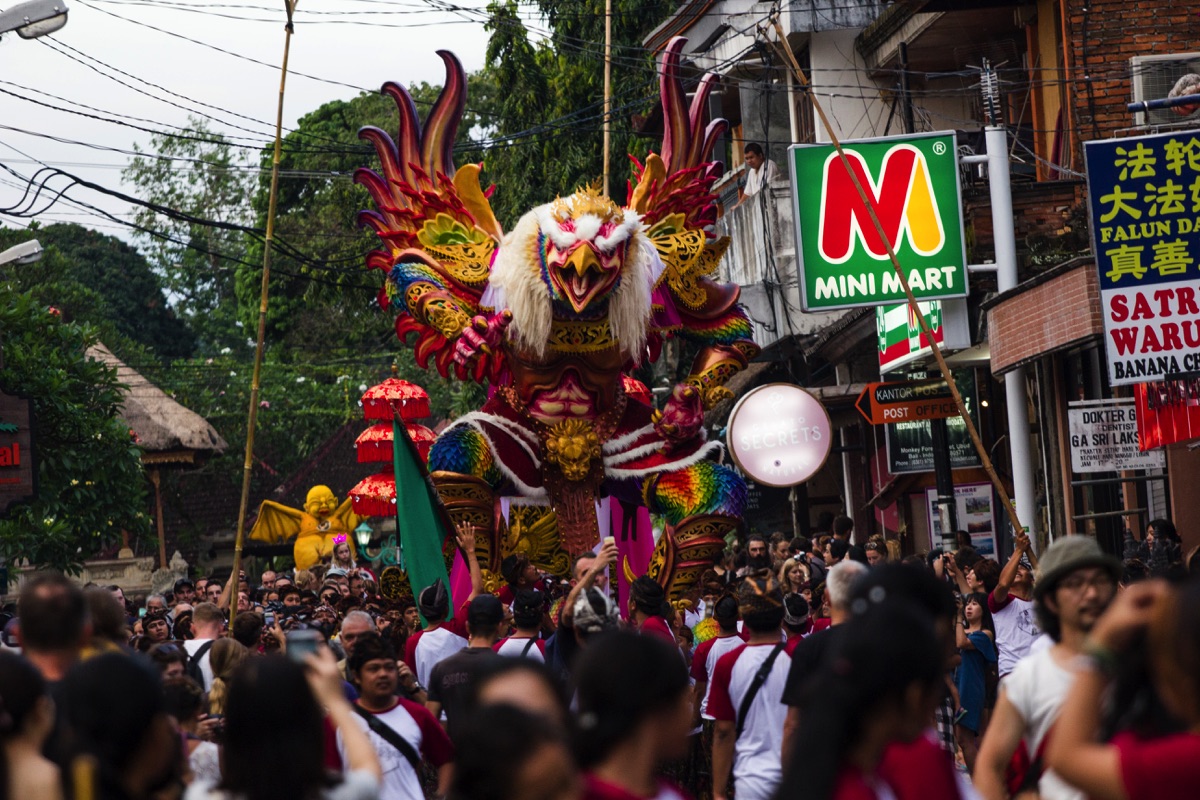
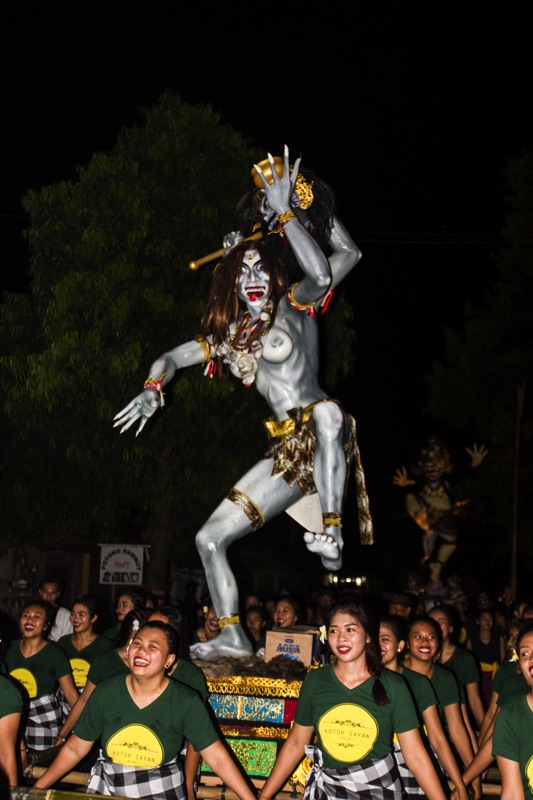
On Nyepi days, all activity stops on Bali (including the airport and all the traffic). Nyepi is a day of self-introspection and 4 prohibitions must be respected (and are enforced by the traditional guards : the pecalang) : no fire (which includes no light at night and no electricity), no activity (bank holiday), no travel (roads, harbor and even the airport are shut down) and no entertainment.
Less known, the sea Nyepi (Nyepi laut) is mostly celebrated on Nusa Lembongan, Ceningan and Penida. Inhabitants pay their respect to the god of the sea Dewa Baruna. On this day all marine activities are prohibited (so no boat, no diving, no fishing…). This day falls always on the full moon of the 4th month of the saka calendar (purnama kapat), so 7 lunar months after Nyepi.
Life-cycle ceremonies
Balinese life is marked by 13 life-cycle rituals (manusa yadnya), which names can vary from place to place.
Pregnancy and early age
The first seven rites take place during the early childhood :
- Pegedong-gedongan held at 6 months of pregnancy to protect the mother and her child.
- Birth ceremonies. Among other things, the placenta must be buried next the house by the father.
- Kepus pungsed at the fall of the umbilical cord. He must be placed in a special shrine. The father is not considered impure anymore.
- Ngelepas hawon : 12 days after birth. Rather minor ceremony, the first contact of the baby with holy water.
- Tutug kambuhan : 42 days after birth, the mother is not considered impure anymore.
- Telubulan : 3 Balinese months after birth (so 105 days), the baby receives the blessing of a priest and a feast is usually organized
- Oton : 6 Balinese months (210 days) which are a year in the Pawuton calendar. Hence it’s considered the anniversary of the child.
Depending on the Balinese region, babies are prevented from touching the ground either until telubulan or oton. On the same occasion, the baby also receive its name
Tooth-filing (Mepandes or Matatah, indo. potong gigi)
3 subsequent rituals are carried out as a teenager :
- Ngempugin when adult theeth begin to appear
- Maketus when the last milk tooth falls out
- Munggah daa/teruna at puberty (most often only given for girls).
The most important rite of this age is probably the tooth filing ceremony (mapandes or matatah). It must be carried out before marriage (sometimes on the very same day for those with low revenues). The ceremony is costly (one have to hire musicians, prepare a feast, make special offerings) and thus often collective (cousins doing it altogether is common).
A specialised priest (sangging) will file the 6 upper teeth. In theory until they are perfectly aligned but, especialy nowadays, the operation is mostly symbolic and thus unpainful.
Besides the esthetical effect of the operation (long teeth are a characteristic of demons), the ritual aims at preserving the teenagers from the traditional 6 sins in Balinese culture (sad ripu) : lust, greed, anger, confusion, drunkness, jealousy.
The next important step of a Balinese life will be his wedding (pawiwihan)
Death rituals
Balinese do no bury their dead but cremate them (ngaben for commoners or pelebon for nobles). By this operation, the soul of the deceased is released and can be reincarnated or assimilated with the Gods (moshka).
When one passes away, his family must decide on whether to bury him (in order to gather enough money to fund a cremation) or to organize a cremation. In the later scenario, the corpse must be injected with formaldehyde within 4 hours after the death.
The body is covered by a piece of fabric and laid down on a bed under the bale (the unclosed pavillon in the middle of the house yard). The bed is shut with curtains and offerings placed near it.
A day is decided for the ritual bath of the corpse. Many relatives will attend this event. The close family first clean the body, then cast holy water on it and recite prayers. A priest will then put perfumed oil in his hair, pieces of mirrors on its eyes, flowers in his nostrils and some piece of irons on the limbs. Thus the deceased will reborn stronger and better looking. After that, the body is wrapped again and put in a coffin where it will stay until the cremation.
When it comes to the cremation, the most impressive are the royal one called pelebon. The body is stored in a giant black bull (for men) or cow (for women) shaped coffin and preceded by a huge cremation tower (bade), on top of which a priest sits.
Below, a video of the cremation of Anak Agung Niang Agun in Ubud in 2018 :
Castes
The caste system has been brought by the Javanese elite fleeing their native island who was converting to Islam. In ancient times, castes were unknown to Balinese who belonged to clans (like it is often the case in East Indonesia). Those who fled Java were often priests or nobles who belonged to the highest caste.
- Brahmana are the descendant of the great priest Dang Hyang Nirartha who came from Java in 1537 and became an advisor of the king of Gelgel who then ruled over the island
- Ksatriya are the descendant of the Balinese upper nobility (kings and warriors)
- Waisya are the descendant of the Balinese lower nobility (king vassals and merchants)
- Sudra are the commoners
One’s caste define the way he can be addressed : the kinship term but also the level of Balinese that must be used (Singgih for the highest ranked individuals, Sor for daily life, Madya is an intermediary level). Modern young Balinese do not always fully master the highest level of Balinese, so they sometimes prefer to use Indonesian when talking to a pedanda rather than making mistakes in high Balinese.
Those social rules are more strictly followed in the eastern regencies of Bali (Gianyar, Klungkung or Karangasem).
Names
When it comes to names, the Balinese have a rather surprising tradition. The first name given to the child depends on its number of siblings.
- For the first child : Wayan, Putu, Gede
- For the second : Made, Kadek, Nengah
- For the third : Nyoman, Komang
- For the fourth : Ketut
If the parents get a 5th child, then they go back to the first rule and they name him Wayan, Putu or Gede. And so on for the 6th, 7th …
Birth control policy have been implemented since the 1970s and Ketut are becoming more rare among younger generations.
Balinese, like Javanese, do not give family names to their children. So you pick whatever you want to add to the first name (Wayan, Made …) in order to get the official administrative name. Thus siblings have totally different last names. Most often this last name comes from the mythology or refer to a quality parents hope their child will develop.
Like in other parts of Indonesia, it is very common to give someone a nickname. You may know someone for years and don’t even know its real name.
By the way many Balinese don’t know the real name of their grandparents. This is because, after the birth of its first child or grandchild, the way people call you change. You become “father/mother of” or “grandfather/grandmother of”.
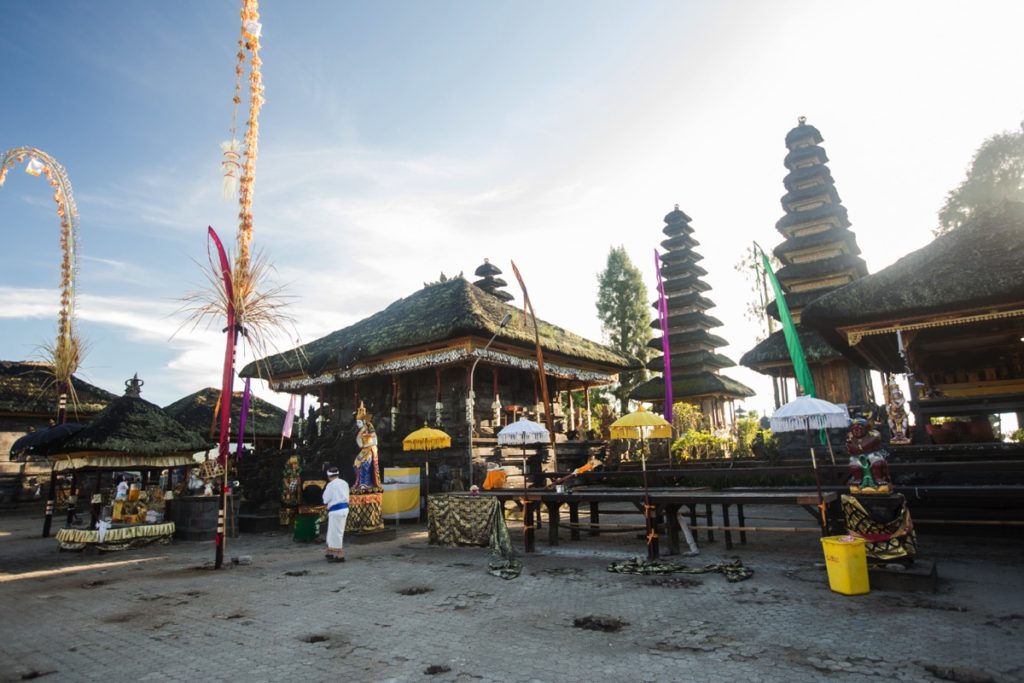
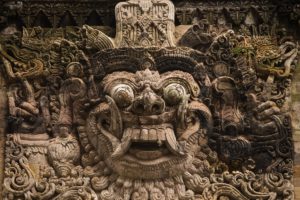
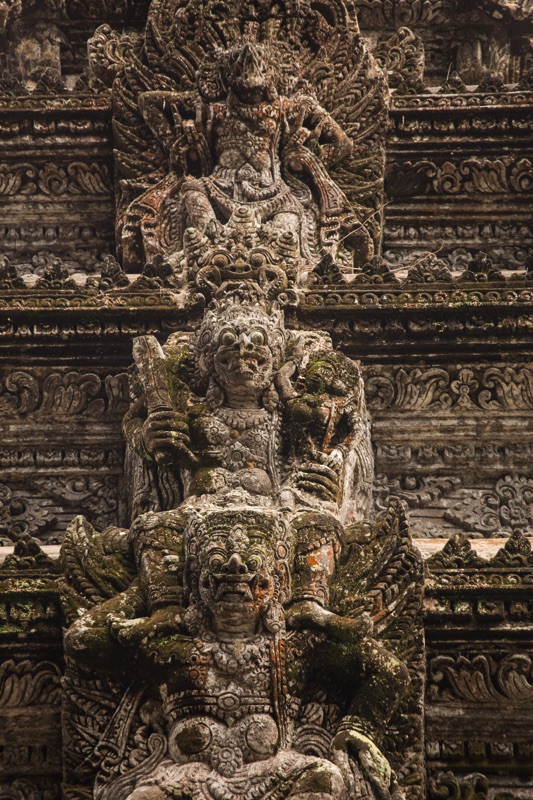
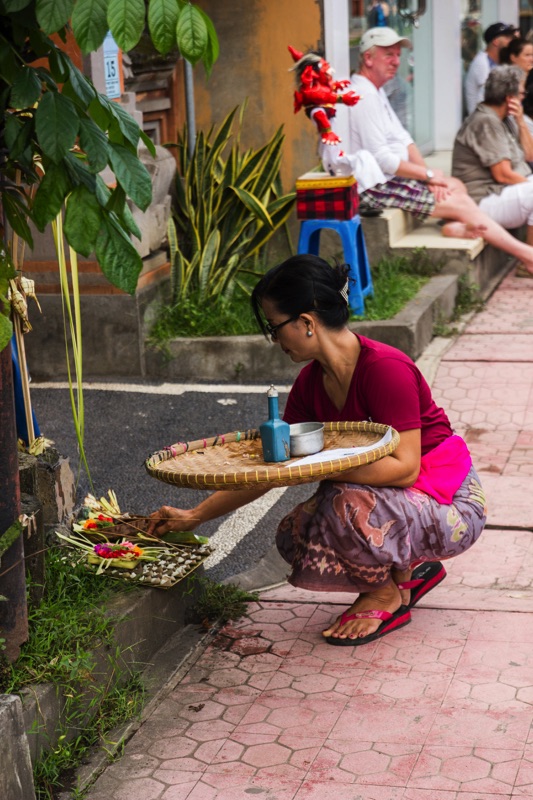
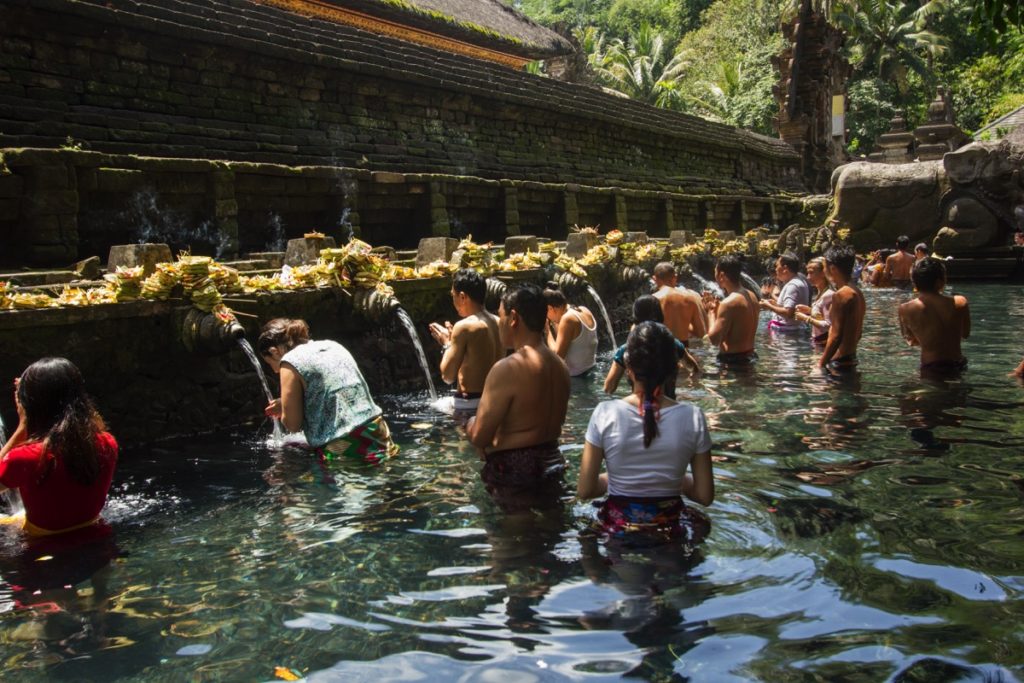
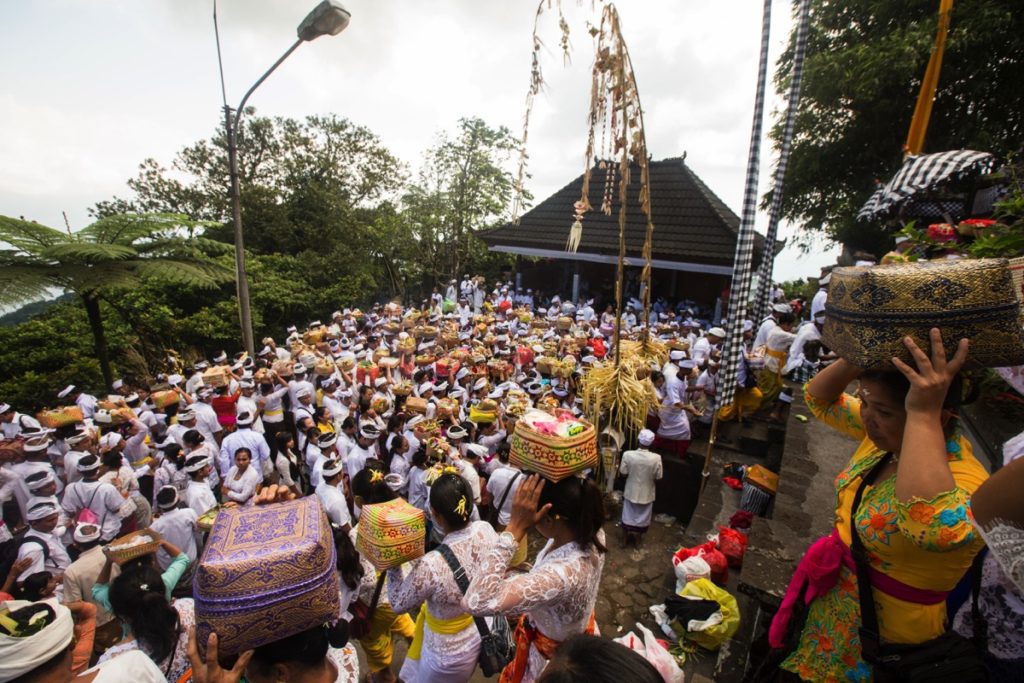
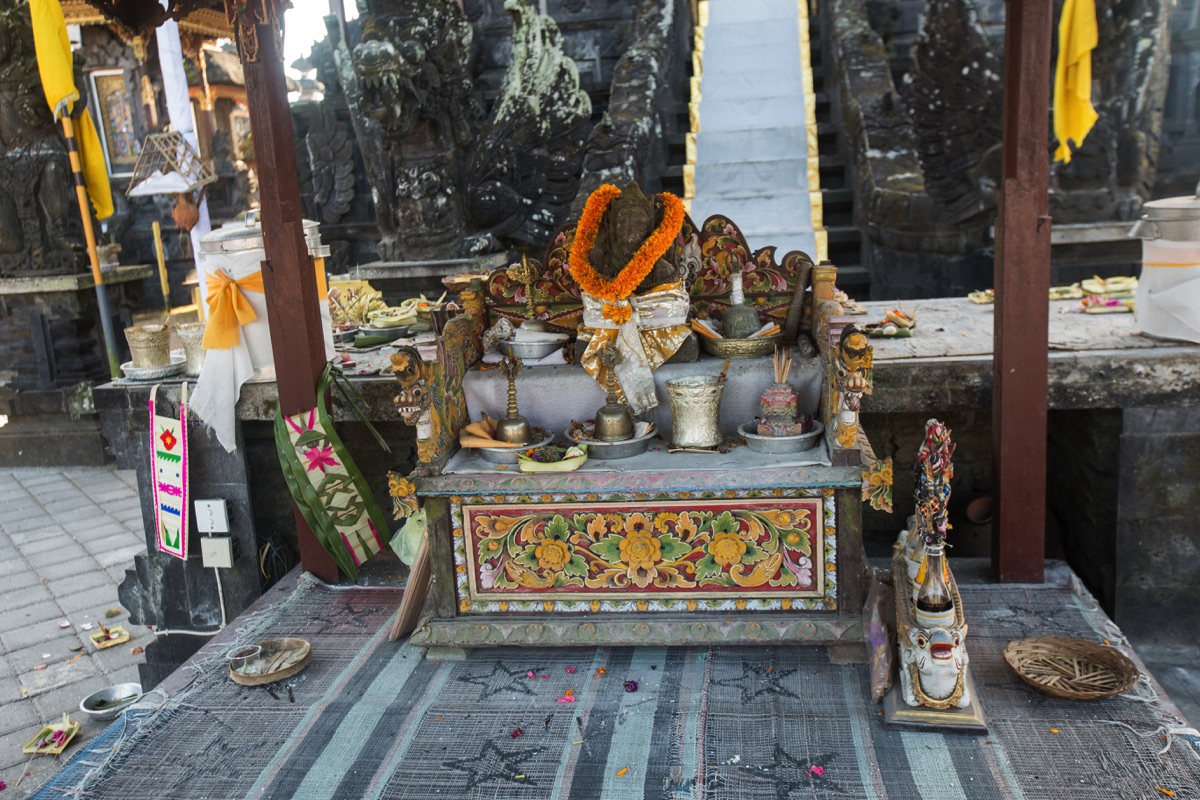

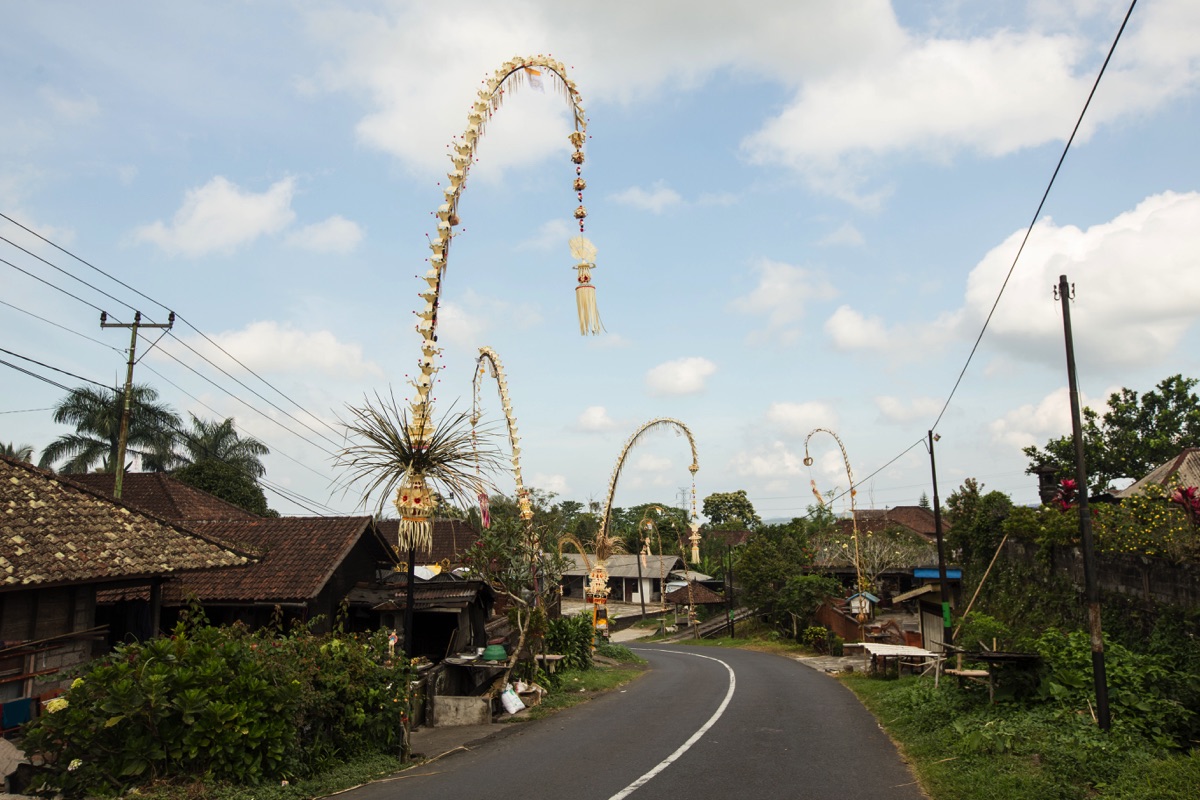
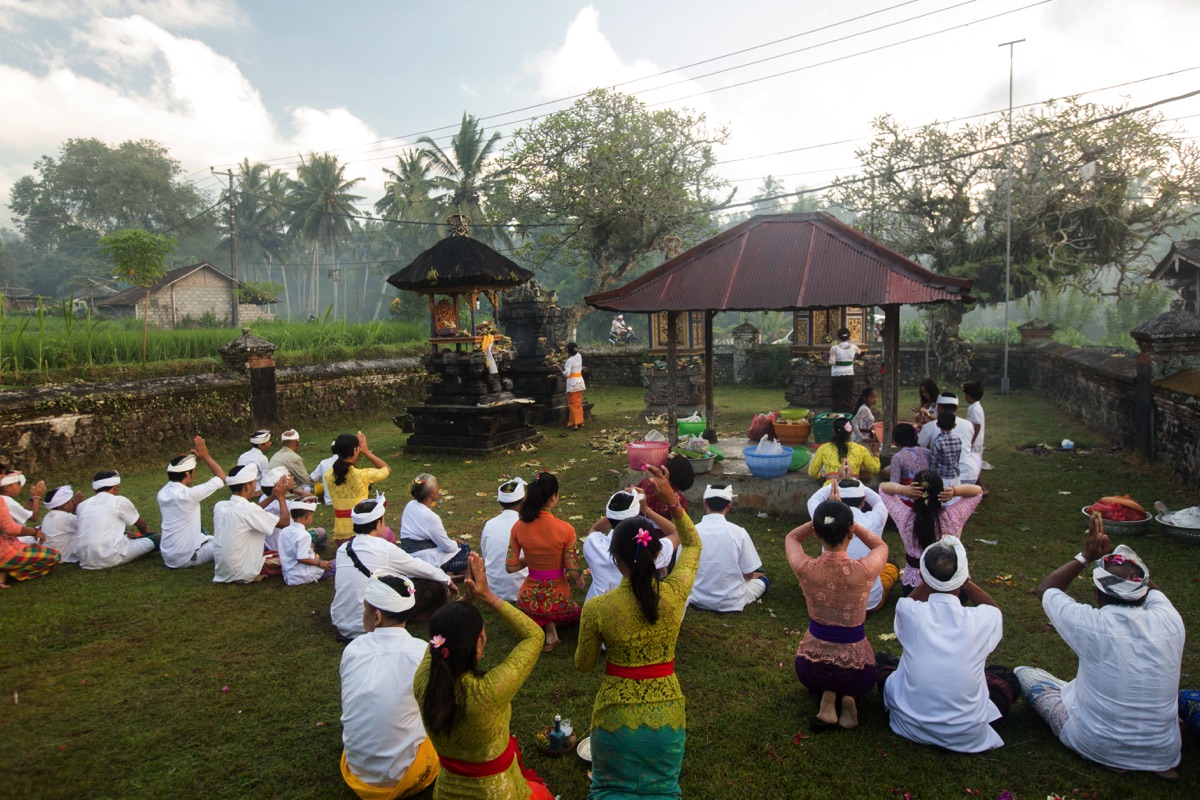
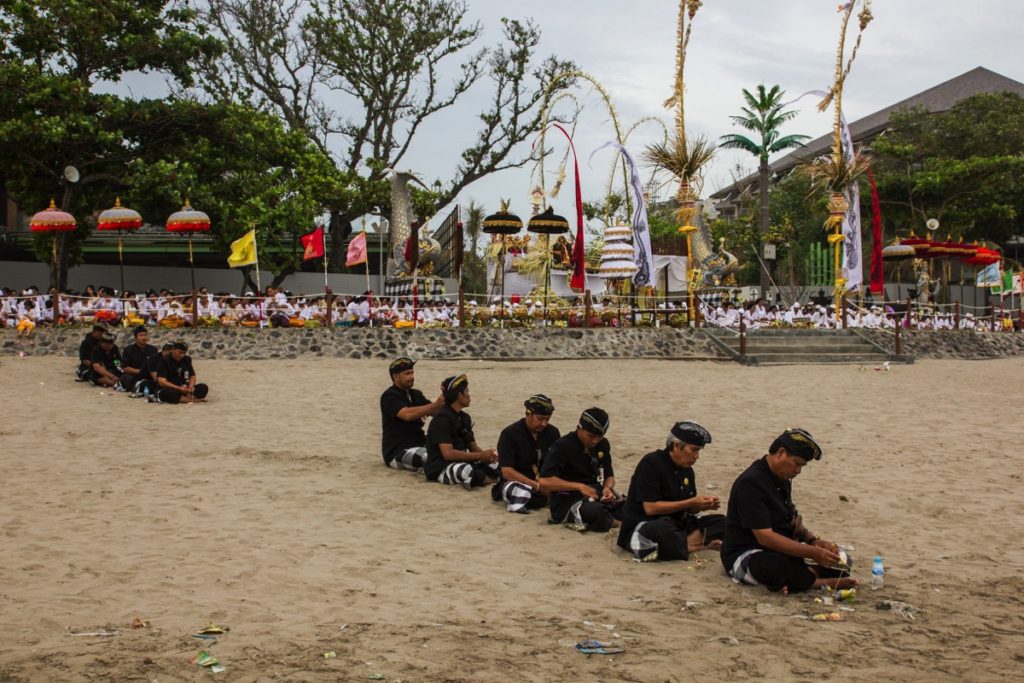
Leave a Reply